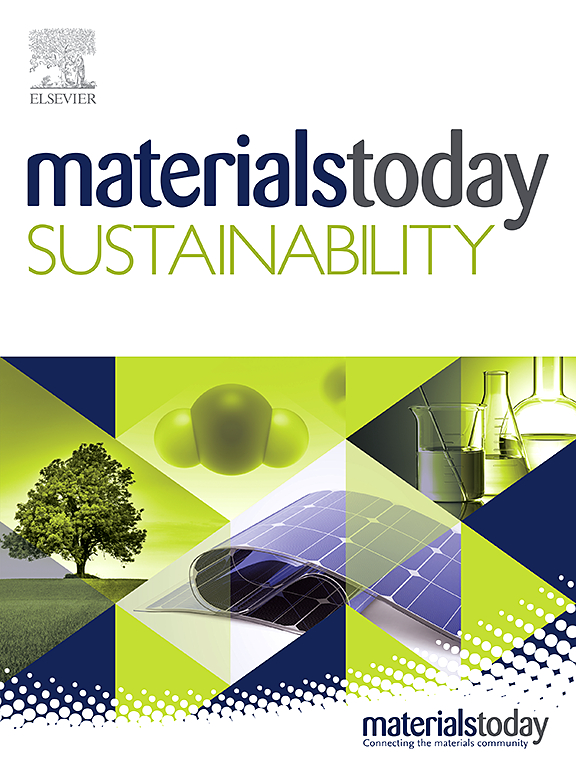Superabsorbent composites based on layered clays and mica: Synthesis, performance modulation and future challenges
IF 7.9
3区 材料科学
Q1 GREEN & SUSTAINABLE SCIENCE & TECHNOLOGY
引用次数: 0
Abstract
Superabsorbent materials (SAMs), three-dimensional (3D) hydrophilic polymer networks capable of absorbing and retaining hundreds of times their weight in water, demonstrate superior performance compared to conventional absorbents (e.g., cotton or cellulose sponges) in both water absorbency and retention efficiency. These exceptional properties render SAMs indispensable for critical applications ranging from personal hygiene products to precision agricultural water management. The absorption characteristics of SAMs are governed by three fundamental parameters: the chemical nature of hydrophilic functional groups, the 3D network architecture, and the cross-linking density. While the selection of monomeric units primarily determines the hydrophilic group composition—a key factor influencing production costs—contemporary research strategies emphasize performance enhancement anc cost reduction through structural modifications of the polymer network while maintaining existing monomer systems. The incorporation of nanoscale additives, particularly 2D nanoclay materials, has emerged as a transformative approach, enabling the fabrication of optimized network structures with enhanced cost-effectiveness. Among these, layered silicate clays represent an ideal class of fillers due to their natural abundance, high aspect ratio, and surface reactivity. The presence of reactive silanol (-SiOH) groups on clay surfaces facilitates the formation of robust hydrogen-bonding networks with polymer matrices, significantly improving both structural integrity and absorption performance. Various phyllosilicate minerals including montmorillonite (MMT), kaolinite, bentonite (BT), vermiculite (VMT), and rectorite (REC), have been successfully incorporated into superabsorbent composites (SACs), demonstrating their effectiveness as functional fillers. This comprehensive review systematically examines: (i) the structural design principles of clay-based SACs, (ii) their structure-property relationships, (iii) underlying absorption mechanisms, and performance optimization strategies. Furthermore, we critically discuss future research directions to fully exploit the potential of these advanced functional materials in next-generation applications.

基于层状粘土和云母的高吸水性复合材料:合成、性能调节和未来挑战
高吸水性材料(SAMs)是一种三维(3D)亲水聚合物网络,能够吸收和保持其重量数百倍的水,与传统的吸水性材料(如棉花或纤维素海绵)相比,在吸水和保持效率方面表现出优越的性能。这些特殊的性能使得sam在从个人卫生产品到精准农业用水管理等关键应用中不可或缺。SAMs的吸收特性由三个基本参数决定:亲水性官能团的化学性质、三维网络结构和交联密度。虽然单体单位的选择主要决定了亲水基团的组成,这是影响生产成本的关键因素,但当代的研究策略强调在保持现有单体体系的同时,通过对聚合物网络的结构修改来提高性能和降低成本。纳米级添加剂的掺入,特别是二维纳米粘土材料,已经成为一种变革性的方法,使制造优化的网络结构具有更高的成本效益。其中,层状硅酸盐粘土因其天然丰度、高纵横比和表面反应性而成为一种理想的填料。粘土表面活性硅醇(-SiOH)基团的存在有助于与聚合物基质形成坚固的氢键网络,显著提高结构完整性和吸收性能。各种层状硅酸盐矿物,包括蒙脱土(MMT)、高岭石、膨润土(BT)、蛭石(VMT)和直托石(REC),已经成功地加入到高吸水性复合材料(SACs)中,证明了它们作为功能性填料的有效性。这篇全面的综述系统地研究了:(i)粘土基SACs的结构设计原则,(ii)它们的结构-性能关系,(iii)潜在的吸收机制和性能优化策略。此外,我们批判性地讨论了未来的研究方向,以充分利用这些先进功能材料在下一代应用中的潜力。
本文章由计算机程序翻译,如有差异,请以英文原文为准。
求助全文
约1分钟内获得全文
求助全文
来源期刊

Materials Today Sustainability
Multiple-
CiteScore
5.80
自引率
6.40%
发文量
174
审稿时长
32 days
期刊介绍:
Materials Today Sustainability is a multi-disciplinary journal covering all aspects of sustainability through materials science.
With a rapidly increasing population with growing demands, materials science has emerged as a critical discipline toward protecting of the environment and ensuring the long term survival of future generations.
 求助内容:
求助内容: 应助结果提醒方式:
应助结果提醒方式:


